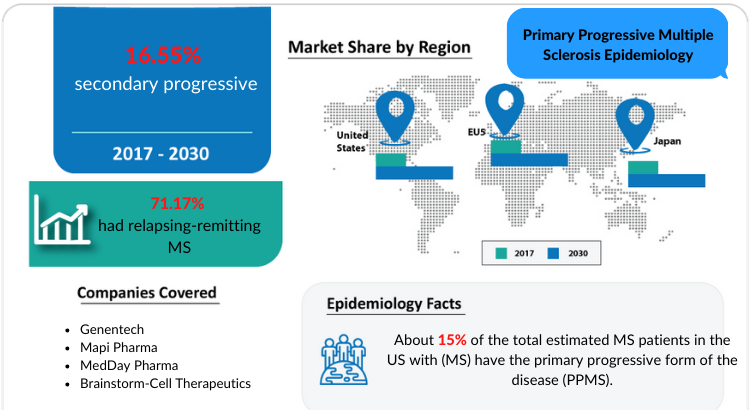DelveInsight has launched a new report on Primary Progressive Multiple Sclerosis Epidemiology
Primary-progressive multiple sclerosis (PPMS) is a neurodegenerative disease that interferes with the brain’s ability to control the body. There are four main types of MS: relapsing-remitting MS (RRMS), primary-progressive MS (PPMS), secondary-progressive MS (SPMS), and progressive-relapsing MS. Each type might be mild, moderate, or severe.
Request for free sample copy- https://www.delveinsight.com/sample-request/primary-progressive-multiple-sclerosis-ppms-epidemiology-forecast
Primary Progressive Multiple Sclerosis Epidemiology historical as well as forecasted Primary Progressive Multiple Sclerosis Epidemiology in the 7MM, covering the United States, EU5 (Germany, France, Italy, Spain and the United Kingdom), and Japan from 2018–2030
Primary Progressive Multiple Sclerosis Epidemiology
PPMS can be further characterized at different points in time as either active (with an occasional relapse and/or evidence of new MRI activity) or not active, as well as with progression (evidence of disease worsening on an objective measure of change over time, with or without relapse or new MRI activity) or without progression. The occurrence and severity of PPMS symptoms vary with each person. Symptoms include headaches, pain in the legs and feet, back pain, muscle spasms, trouble in walking, vision problems, etc. In addition, this condition affects men and women equally.
Key facts of the Primary Progressive Multiple Sclerosis Epidemiology Report
- As per the National Multiple Sclerosis Society, about 15% of the total estimated MS patients in the United States with multiple sclerosis (MS) have the primary progressive form of the disease (PPMS).
- According to a study by Costa-Arpín et al. (2020), in a Spanish cohort, 71.17% had relapsing-remitting MS, 16.55% secondary progressive MS, 7.59% primary progressive MS, and 0.69% progressive relapsing MS.
- As per the estimates provided by Columbia University Medical Center (2018), on average, people with the primary progressive form of MS start having symptoms between ages 35 and 39.
- According to a review article titled “Primary Progressive Multiple Sclerosis” published by Giovannon et al. (2012), the female to male ratio is generally 1:1 with regard to PPMS and 2 or even 3:1 for relapse onset disease. As seen by changes in the sex ratio, the increasing female preponderance of MS seems to be driven by relapse-onset disease, with the incidence of PPMS remaining relatively constant.
Primary Progressive Multiple Sclerosis Epidemiology Segmentation
- Prevalent Population of Multiple Sclerosis (MS) in 7MM [2017–2030]
- Total Prevalent Cases of Primary-progressive Multiple Sclerosis [2017–2030]
- Diagnosed Cases of Primary-Progressive Multiple Sclerosis in the 7MM [2017–2030]
- Treatable Cases of Primary-progressive Multiple Sclerosis In the 7MM [2017–2030]
Primary Progressive Multiple Sclerosis Treatment
Primary-progressive multiple sclerosis (PPMS) is a rare disease subtype characterized by continuous disability worsening from the onset. It is noteworthy that the accumulation of disability without relapses characterizes PPMS, due to which the PPMS course occurs from the onset, whereas secondary progressive MS (SPMS) course follows a relapsing-remitting phase. The ultimate goal in PPMS therapy focuses on the reversal of disability and the arrest of disease progression. In general, the current treatment of PPMS is based on the severity of the disease, and these treatment approaches are symptomatic and supportive in nature.
Primary Progressive Multiple Sclerosis Epidemiology Report Highlights
- 11-Year Forecast of Primary Progressive Multiple Sclerosis (PPMS) epidemiology
- 7MM Coverage
- Total Cases of Primary Progressive Multiple Sclerosis (PPMS)
- Total Cases of Primary Progressive Multiple Sclerosis (PPMS) according to segmentation
- Diagnosed cases of Primary Progressive Multiple Sclerosis (PPMS)
Request for free sample copy- https://www.delveinsight.com/sample-request/primary-progressive-multiple-sclerosis-ppms-epidemiology-forecast
Table of content
1. Key Insights
2. Executive Summary of Primary Progressive Multiple Sclerosis (PPMS)
3. Primary Progressive Multiple Sclerosis (PPMS): Disease Background and Overview
4. Patient Journey
5. Epidemiology and Patient Population
6. Treatment Algorithm, Current Treatment, and Medical Practices
7. KOL Views
8. Unmet Needs
9. Appendix
10. DelveInsight Capabilities
11. Disclaimer
12. About DelveInsight
Reasons to buy
The Primary Progressive Multiple Sclerosis (PPMS) Epidemiology report will allow the user to –
- Develop business strategies by understanding the trends shaping and driving the global Primary Progressive Multiple Sclerosis (PPMS) market
- Quantify patient populations in the global Primary Progressive Multiple Sclerosis (PPMS) market to improve product design, pricing, and launch plans
- Organize sales and marketing efforts by identifying the age groups and sex that present the best opportunities for Primary Progressive Multiple Sclerosis (PPMS) therapeutics in each of the markets covered
- Understand the magnitude of Primary Progressive Multiple Sclerosis (PPMS) population by its epidemiology
- The Primary Progressive Multiple Sclerosis (PPMS) Epidemiology Model developed by DelveInsight is easy to navigate, interactive with dashboards, and epidemiology based with transparent and consistent methodologies. Moreover, the model supports data presented in the report and showcases disease trends over 11-year forecast period using reputable sources
Related Reports
Media Contact
Company Name: DelveInsight Business Research LLP
Contact Person: Yash Bhardwaj
Email: Send Email
Phone: 9193216187
Address:304 S. Jones Blvd #2432
Country: United States
Website: www.delveinsight.com/

